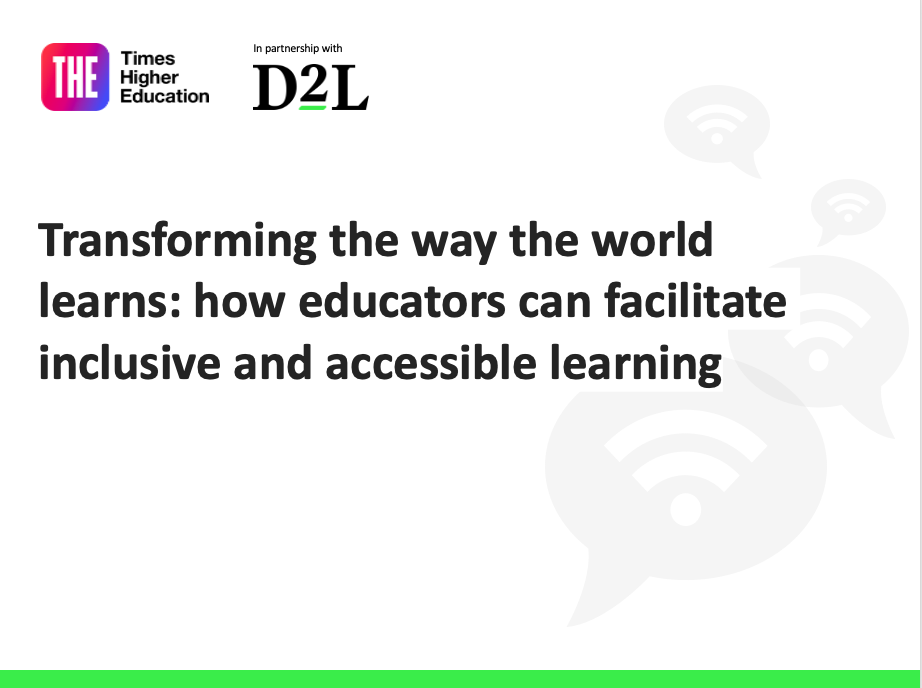Institutions can leverage modern technology to democratise access to education and enhance the learning experience for all students. A Times Higher Education webinar, held in partnership with D2L, discussed strategies for building accessible learning environments with impact and advancing the conversation on educational equity.
“The awareness around mobility and sensory impairments, mental health issues, specific learning differences as well as medical conditions, which may impact day-to-day activities, has arguably never been greater,” said Rob Telfer, director of higher education for EMEA at D2L. “However, there is clearly still much to be done. Technology, infrastructure, systems design, policy and, of course, committed accessibility champions all clearly have a significant role to play in ensuring that we do not unfairly disadvantage any of our learners.”
“Accessibility means striving to create a learning environment where every student is supported and enabled to thrive and achieve their full potential,” said Emma O’Neill, associate professor in small animal medicine at University College Dublin. This becomes even more important in online education, where it might be harder for students to quickly reach out to staff to flag issues, said Jo Elliott, reader in learning design at Queen Mary University of London.
Understanding that every learner is unique and has different needs is vital to accessibility in education, said Sam Chandrashekar, global accessibility lead at D2L. “We must focus on enabling equity, which is about giving each learner what they need to set them up for success rather than giving everyone the same thing in the name of equality,” said Chandrashekhar.
“Accessibility, especially in the context of learning technology, is about providing choices to help learners consume content in multiple formats, engage in learning in multiple ways and demonstrate their knowledge and skills in multiple forms,” said Chandrasekhar. Identifying the different accessibility challenges learners face and finding time to explore solutions can be a challenge for educators, Elliott said. But it is important to empower them to go beyond base-level accessibility tools, such as transcripts and captions, and create space for students to “bring their whole selves” to the learning experience, she added.
Chandrashekar emphasised the importance of viewing accessibility as a leadership imperative, with leaders assuming the responsibility for creating and supporting policies, plans and governance frameworks that improve accessibility in their institutions. However, everyone in an education ecosystem needs to take responsibility for practising accessibility.
O’Neill shared an example of the Universal Design for Learning (UDL) digital badge programme in Ireland, run jointly by University College Dublin and the Association for Higher Education and Disability. The programme introduces people working in higher and further education to the CAST UDL, an educational framework developed by CAST to optimise teaching and learning based on scientific insights into how people learn. The programme’s Plus-One approach prompts participants to identify and adopt one achievable redesign goal in their immediate setting to enhance accessibility.
Communication, co-creation and collaboration are effective strategies for improving accessibility, the panellists said. Elliott shared an example of an impactful initiative launched by Deakin University in Australia, where learners with lived experience of disability acted as mentors for staff members, sharing their experiences of accessibility along with recommendations for positive change.
Incorporating students in the learning design process, proactively seeking feedback on what they need at all stages and offering choice helps universities create more accessible and inclusive learning experiences, Elliott added. D2L’s approach to removing barriers for educators and learners with disabilities is human-centred. It follows the IDEA framework for inclusion, diversity, equity and accessibility and practises inclusive design in building products and services. “We involve people with disabilities at every stage of the product development cycle,” said Chandrashekar. “Our belief is that technology is a bridge connecting the humans involved in teaching and learning.”
The panel:
- Sam Chandrashekar, global accessibility lead, D2L
- Jo Elliott, reader in learning design, Digital Education Studio, Queen Mary University of London
- Emma O’Neill, associate professor in small animal medicine, University College Dublin
- Rob Telfer, director of higher education for EMEA, D2L
Find more resources on accessible and inclusive teaching here. Find out more about D2L.
To learn more about creating inclusive and accessible learning environments, register for D2L’s live demo of Brightspace here.


comment